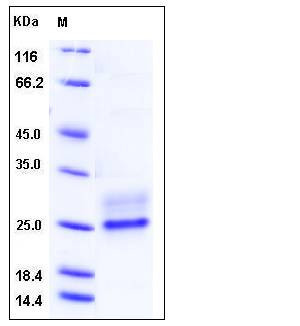Ferret CD20 / MS4A-1 Protein (His Tag)
CD20, MS4A1
- 100ug (NPP3146) Please inquiry
| Catalog Number | P60004-F08H |
|---|---|
| Organism Species | Ferret |
| Host | Human Cells |
| Synonyms | CD20, MS4A1 |
| Molecular Weight | The recombinant Ferret CD20 consists of 96 amino acids and has a calculated molecular mass of 11.3 kDa. The apparent molecular mass of the recombinant protein is approximately 25 kDa in SDS-PAGE under reducing conditions due to glycosylation. |
| predicted N | Glu 213 |
| SDS-PAGE |  |
| Purity | > 90 % as determined by SDS-PAGE |
| Protein Construction | A DNA sequence encoding the C-terminal cytoplasmic domain of Ferret (Mustela putorius furo) CD20 (Glu 213-Pro 297) was expressed, with a polyhistidine tag at the C-terminus and a signal peptide at the N-terminus. |
| Bio-activity | |
| Research Area | Immunology |Adaptive Immunity |B Cell |B Cell CD Antigen |
| Formulation | Lyophilized from sterile PBS, pH 7.4 1. Normally 5 % - 8 % trehalose and mannitol are added as protectants before lyophilization. Specific concentrations are included in the hardcopy of COA. |
| Background | CD20 (membrane-spanning 4-domains, subfamily A, member 1), also known as MS4A1, is a member of the membrane-spanning 4A gene family. Members of this nascent protein family are characterized by common structural features and similar intron/exon splice boundaries and display unique expression patterns among hematopoietic cells and nonlymphoid tissues. CD20 / MS4A1 is expressed on all stages of B cell development except the first and last. CD20 / MS4A1 is present from pre-pre B cells through memory cells, but not on either pro-B cells or plasma cells. It is a B-lymphocyte surface molecule which plays a role in the development and differentiation of B-cells into plasma cells. CD20 / MS4A1may be involved in the regulation of B-cell activation and proliferation. Defects in CD20 / MS4A1 are the cause of immunodeficiency common variable type 5(CVID5). CVID5 is a primary immunodeficiency characterized by antibody deficiency, hypogammaglobulinemia, recurrent bacterial infections and an inability to mount an antibody response to antigen. The defect results from a failure of B-cell differentiation and impaired secretion of immunoglobulins; the numbers of circulating B-cells is usually in the normal range, but can be low. |
| Reference |
